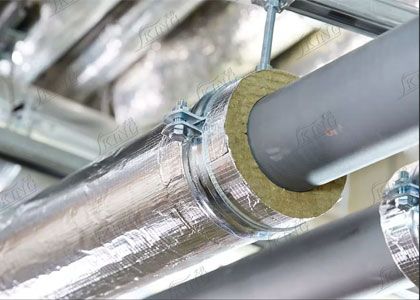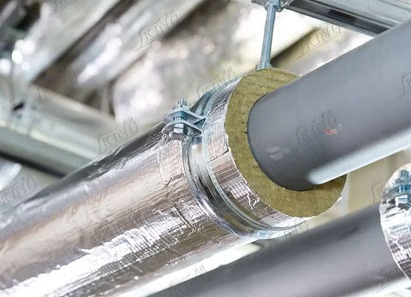
The following article systematically explains the advantages and practical points of using rock wool pipe (rock wool pipe shell) for insulation in HVAC system pipeline renovation from the aspects of energy-saving principles, actual benefits, installation points and economic analysis, helping engineers and owners understand how to achieve significant reduction in pipeline energy consumption and improvement in system operation efficiency through scientific material selection and construction.
The rock wool pipe shell commonly used in HVAC systems is made of high-melting-point basalt as raw material, which is centrifugally fiberized after high-temperature melting above 1,450℃ and sprayed with environmentally friendly adhesive. The density is generally 80–160 kg/m³, and the thickness and specifications can be customized according to the pipe diameter and temperature grade.
It has the characteristics of non-flammability, water repellency, pressure resistance, and temperature resistance (usable temperature can reach above 600℃), and is suitable for insulation and fire prevention of hot and cold, hot and cold alternating, and high-temperature steam pipelines.
The porous fiber structure of the rock wool pipe shell can significantly block heat conduction. Studies have shown that heat pipes (such as hot water pipes) can reduce heat loss by 20% after insulation, while cold pipes (such as chilled water pipes) can reduce energy consumption by up to 50%.
Rock wool insulation of chilled water pipes and aluminum foil surface materials can effectively prevent condensation on the pipe surface, avoid slippery pipe corridors and cold loss; at the same time, continuous coating can reduce the thermal bridge effect at the pipe support and hanger, and achieve overall thermal performance stability.
1. Energy saving range: According to actual construction measurements, hot and cold pipe insulation can save system energy consumption by about 20%-50%, respectively, and the investment cost is usually recovered within 3 years.
2. Temperature maintenance: Under the same pipe length and initial temperature difference conditions, the temperature of the uninsulated pipe can decay by about 2-4 °C every 5 m, while the rock wool insulation pipe decays by only about 0.5-1 °C, significantly improving the terminal temperature control accuracy.
3. System efficiency: After pipe insulation, the HVAC system's load demand on the terminal air conditioning unit decreases, which can reduce the output power of the compressor and boiler and improve the overall COP (coefficient of performance) by about 10%-15%.

Hot water pipe: The recommended insulation layer thickness is 30-50 mm, and the density is 100 kg/m³;
Chilled water pipe: The recommended thickness is 40-60 mm and is combined with an aluminum foil vapor barrier.
End closure: Prefabricated parts are required for pipe ends, elbows, tees, etc., to ensure seamless connection.
Moisture-proof treatment: Aluminum foil or plastic vapor barriers are required for cold pipes to prevent water vapor from penetrating into the fiber layer.
Fixing method: Stainless steel hoops, hanging parts, and anti-vibration gaskets are used to avoid loosening or cracking of the insulation layer caused by thermal expansion and contraction.
1. Payback period: Based on the length of the pipeline, operating conditions, and local electricity prices, the investment in pipeline insulation can be recovered within 2-4 years in conventional commercial construction projects.
2. Reduced operation and maintenance costs: The insulation system can reduce the operating time of circulating water pumps and air conditioning units, extend equipment life, and reduce maintenance needs.
3. Carbon emission reduction: The energy-saving effect can reduce CO₂ emissions by about 150–400 kg per 10 m pipeline per year, helping the building achieve green building certification.
The use of rock wool shell and pipe to transform HVAC system pipes is an efficient strategy that takes into account energy saving and emission reduction, and fire safety. Under the premise of reasonable material selection, scientific design, and standardized construction, it can not only greatly reduce system heat loss and operating costs but also improve system stability and service life, bringing considerable economic and environmental value to building operations. It is recommended to include pipe insulation in the design and budget at the beginning of the project to achieve the win-win goal of long-term energy saving and green operation.
If you have a purchase demand for high-quality rock wool pipes or want to know more details, please contact us, IKING GROUP. We are a basalt wool manufacturer with a complete rock wool production line. Let us provide you with high-quality customized services.